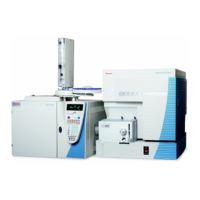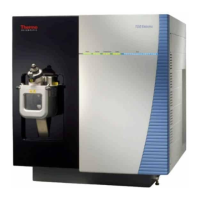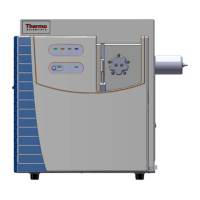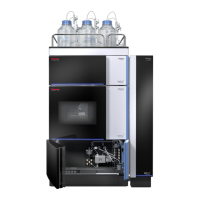1
Introduction
Scan Modes
Thermo Scientific TSQ Quantum XLS Series User Guide 7
Q1MS and Q3MS Scan Modes
The Q1MS and Q3MS scan modes perform only one stage of mass analysis. The mass
spectrum obtained is equivalent to the mass spectrum obtained from an instrument with a
single mass analyzer. In the one stage of analysis, ions formed in the ion source enter the
analyzer assembly. One of the mass analyzers (Q1 or Q3) is scanned to obtain a complete mass
spectrum. The other rod assemblies (Q2 and Q3, or Q1 and Q2, respectively) act as ion
transmission devices. The Q1MS scan mode uses Q1 as the mass analyzer; the Q3MS scan
mode uses Q3 as the mass analyzer.
Product Scan Mode
The Product scan mode performs two stages of analysis. In the first stage, ions formed in the
ion source enter Q1, which is set to transmit ions of one mass-to-charge ratio. Ions selected by
this first stage of mass analysis are called parent ions. (As a result, Q1 is referred to as the
parent mass analyzer, and the mass-to-charge ratio of ions transmitted by the parent mass
analyzer is referred to as the parent set mass.) Parent ions selected by Q1 then enter Q2, which
is surrounded by the collision cell.
In the second stage of analysis, ions in the collision cell can fragment further to produce
product ions. Two processes produce product ions: by unimolecular decomposition of
metastable ions or by interaction with argon collision gas present in the collision cell. This
latter step is known as collision-induced dissociation (CID). Ions formed in the collision cell
enter Q3 (the product mass analyzer) for the second stage of mass analysis. Q3 is scanned to
obtain a mass spectrum that shows the product ions produced from the fragmentation of the
selected parent ion.
A mass spectrum obtained in the Product scan mode (product mass spectrum) is the mass
spectrum of a selected parent ion.
Figure 3 illustrates the Product scan mode.
Note For convenience, when referring to the first, second, and third rod assemblies as
pieces of hardware, you call them Q1, Q2, and Q3, respectively. However, for clarity in
discussing their function in MS/MS scan modes, you refer to them as the parent mass
analyzer, collision cell (ion transmission device surrounded by the collision cell), and
product mass analyzer, respectively.

